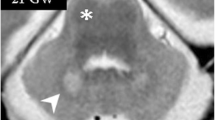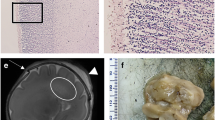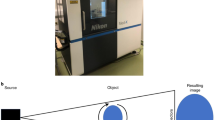Abstract
Purpose
The aim of our study was to evaluate the postmortem micro-CT anatomy of early fetal human fetal brains, either in situ or isolated.
Methods
We studied 12 ex vivo specimens, 9 whole human fetuses (9–18 GW), and 3 isolated samples (16–26 GW).
Specimens were fixed in formalin, then immersed in Lugol solution. Images were evaluated by two neuroradiologists. The depiction of CNS structures was defined based on the comparison between micro-CT images and a reference histologic anatomical Atlas of human brain development.
Results
Micro-CT provided informative high-resolution brain images in all cases, with the exception of one case (9 weeks) due to advanced maceration. All major CNS structures (i.e., brain hemispheres, layering, ventricles, germinal neuroepithelium, basal ganglia, corpus callosum, major cranial nerves, and structures of the head and neck) were recognizable.
Conclusions
Micro-CT imaging of the early fetal brain is feasible and provides high-quality images that correlate with the histological Atlas of the human brain, offering multiplanar and volumetric images that can be stored and shared for clinical, teaching, and research purposes.



Similar content being viewed by others
Abbreviations
- Micro-CT:
-
Micro-focus computed tomography
- GA:
-
Gestational age
- GZ:
-
Germinal neuroepithelium or zone
- GE:
-
Ganglionic eminence
- IZ:
-
Intermediate zone
- SP:
-
Subplate
- CP:
-
Cortical plate
- MZ:
-
Marginal zone
References
Engels AC, Joyeux L, Brantner C, De Keersmaecker B, De Catte L, Baud D, Deprest J, Van Mieghem T (2016) Sonographic detection of central nervous system defects in the first trimester of pregnancy. Prenat Diagn 36:266–273. https://doi.org/10.1002/pd.4770
Syngelaki A, Chelemen T, Dagklis T, Allan L, Nicolaides KH (2011) Challenges in the diagnosis of fetal non-chromosomal abnormalities at 11-13 weeks. Prenat Diagn 31:90–102. https://doi.org/10.1002/pd.2642
Katorza E, Achiron R (2012) Early pregnancy scanning for fetal anomalies--the new standard? Clin Obstet Gynecol 55:199–216. https://doi.org/10.1097/GRF.0b013e3182446ae9
Volpe P, Contro E, Fanelli T, Muto B, Pilu G, Gentile M (2016) Appearance of fetal posterior fossa at 11-14 weeks in fetuses with Dandy-Walker malformation or chromosomal anomalies. Ultrasound Obstet Gynecol 47:720–725. https://doi.org/10.1002/uog.14883
Contro E, Volpe P, De Musso F, Muto B, Ghi T, De Robertis V, Pilu G (2014) Open fourth ventricle prior to 20 weeks’ gestation: a benign finding? Ultrasound Obstet Gynecol 43:154–158. https://doi.org/10.1002/uog.13227
Arthurs OJ, Thayyil S, Pauliah SS, Jacques TS, Chong WK, Gunny R, Saunders D, Addison S, Lally P, Cady E, Jones R, Norman W, Scott R, Robertson NJ, Wade A, Chitty L, Taylor AM, Sebire NJ, Group MRIAS (MaRIAS) C (2015) Diagnostic accuracy and limitations of post-mortem MRI for neurological abnormalities in fetuses and children. Clin Radiol 70:872–880. https://doi.org/10.1016/j.crad.2015.04.008
Gilbert-Barness E, Spicer DE, Steffensen TS (2014) Handbook of pediatric autopsy pathology. Springer
Connolly AJ, Finkbeiner WE, Ursell PC, Richard L, Davis M (2016) Autopsy pathology: a manual and atlas. Elsevier
Lombardi CM, Zambelli V, Botta G, Moltrasio F, Cattoretti G, Lucchini V, Fesslova V, Cuttin MS (2014) Postmortem microcomputed tomography (micro-CT) of small fetuses and hearts. Ultrasound Obstet Gynecol 44:600–609. https://doi.org/10.1002/uog.13330
Thayyil S, Sebire NJ, Chitty LS, Wade A, Chong W, Olsen O, Gunny RS, Offiah AC, Owens CM, Saunders DE, Scott RJ, Jones R, Norman W, Addison S, Bainbridge A, Cady EB, De VE, Robertson NJ, Taylor AM (2013) Post-mortem MRI versus conventional autopsy in fetuses and children: a prospective validation study. Lancet 382:223–233. https://doi.org/10.1016/S0140-6736(13)60134-8
Hutchinson JC, Arthurs OJ, Ashworth MT, Ramsey AT, Mifsud W, Lombardi CM, Sebire NJ (2016) Clinical utility of postmortem microcomputed tomography of the fetal heart: diagnostic imaging vs macroscopic dissection. Ultrasound Obstet Gynecol 47:58–64. https://doi.org/10.1002/uog.15764
Lewis C, Hill M, Arthurs O, Hutchinson C, Chitty L, Sebire N (2018) Factors affecting uptake of postmortem examination in the prenatal, perinatal and paediatric setting. BJOG An Int J Obstet Gynaecol 125:172–181. https://doi.org/10.1111/1471-0528.14600
Thayyil S, Cleary JO, Sebire NJ, Scott RJ, Chong K, Gunny R, Owens CM, Olsen OE, Offiah AC, Parks HG, Chitty LS, Price AN, Yousry TA, Robertson NJ, Lythgoe MF, Taylor AM (2009) Post-mortem examination of human fetuses: a comparison of whole-body high-field MRI at 9.4 T with conventional MRI and invasive autopsy. Lancet (London, England) 374:467–475. https://doi.org/10.1016/S0140-6736(09)60913-2
Scola E, Conte G, Palumbo G, Avignone S, Cinnante CM, Boito S, Persico N, Rizzuti T, Triulzi F (2018) High resolution post-mortem MRI of non-fixed in situ foetal brain in the second trimester of gestation: Normal foetal brain development. Eur Radiol 28:363–371. https://doi.org/10.1007/s00330-017-4965-y
Kang X, Cannie MM, Arthurs OJ, Segers V, Fourneau C, Bevilacqua E, Cos Sanchez T, Sebire NJ, Jani JC (2017) Post-mortem whole-body magnetic resonance imaging of human fetuses: a comparison of 3-T vs. 1.5-T MR imaging with classical autopsy. Eur Radiol 27:3542–3553. https://doi.org/10.1007/s00330-016-4725-4
Metscher BD (2009) MicroCT for developmental biology: a versatile tool for high-contrast 3D imaging at histological resolutions. Dev Dyn 238:632–640. https://doi.org/10.1002/dvdy.21857
Hutchinson JC, Barrett H, Ramsey AT, Haig IG, Guy A, Sebire NJ, Arthurs OJ (2016) Virtual pathological examination of the human fetal kidney using micro-CT. Ultrasound Obstet Gynecol 48:663–665. https://doi.org/10.1002/uog.15859
Hutchinson JC, Kang X, Shelmerdine SC, Segers V, Lombardi CM, Cannie MM, Sebire NJ, Jani JC, Arthurs OJ (2018) Postmortem microfocus computed tomography for early gestation fetuses: a validation study against conventional autopsy. Am J Obstet Gynecol 218:445.e1–445.e12. https://doi.org/10.1016/j.ajog.2018.01.040
Thayyil S (2011) Less invasive autopsy: an evidenced based approach. Arch Dis Child 96:681–687. https://doi.org/10.1136/adc.2009.165704
De Crespigny A, Bou-reslan H, Nishimura MC, Phillips H, Richard A, Carano D, Arceuil HED (2009) 3D microCT of the postmortem brain. J Neurosci Methods 171:207–213. https://doi.org/10.1016/j.jneumeth.2008.03.006.3D
Dobrivojević M, Bohaček I, Erjavec I, Gorup D, Gajović S (2013) Computed microtomography visualization and quantification of mouse ischemic brain lesion by nonionic radio contrast agents. Croat Med J 54:3–11. https://doi.org/10.3325/cmj.2013.54.3
Gignac PM, Kley NJ, Clarke JA, Colbert MW, Morhardt AC, Cerio D, Cost IN, Cox PG, Daza JD, Early CM, Echols MS, Henkelman RM, Herdina AN, Holliday CM, Li Z, Mahlow K, Merchant S, Müller J, Orsbon CP, Paluh DJ, Thies ML, Tsai HP, Witmer LM (2016) Diffusible iodine-based contrast-enhanced computed tomography (diceCT): an emerging tool for rapid, high-resolution, 3-D imaging of metazoan soft tissues. J Anat 228:889–909. https://doi.org/10.1111/joa.12449
Degenhardt K, Wright AC, Horng D, Padmanabhan A, Epstein JA (2010) Rapid 3D phenotyping of cardiovascular development in mouse embryos by micro-CT with iodine staining. Circ Cardiovasc Imaging 3:314–322. https://doi.org/10.1161/CIRCIMAGING.109.918482
Li Z, Clarke JA, Ketcham RA, Colbert MW, Yan F (2015) An investigation of the efficacy and mechanism of contrast-enhanced X-ray computed tomography utilizing iodine for large specimens through experimental and simulation approaches. BMC Physiol 15(5). https://doi.org/10.1186/s12899-015-0019-3
Kostovic I, Vasung L (2009) Insights from in vitro fetal magnetic resonance imaging of cerebral development. Semin Perinatol 33:220–233. https://doi.org/10.1053/j.semperi.2009.04.003
Author information
Authors and Affiliations
Corresponding author
Ethics declarations
Funding
No funding was received for this study.
Conflict of interest
The authors declare that they have no conflict of interest.
Ethical approval
All procedures performed in the studies involving human participants were in accordance with the ethical standards of the institutional and/or national research committee and with the 1964 Helsinki Declaration and its later amendments or comparable ethical standards. For this type of study formal consent is not required.
Informed consent
For this type of retrospective study formal consent is not required.
Additional information
Publisher’s note
Springer Nature remains neutral with regard to jurisdictional claims in published maps and institutional affiliations.
Electronic supplementary material
ESM 1
(MOV 16966 kb)
Rights and permissions
About this article
Cite this article
Lombardi, S., Scola, E., Ippolito, D. et al. Micro-computed tomography: a new diagnostic tool in postmortem assessment of brain anatomy in small fetuses. Neuroradiology 61, 737–746 (2019). https://doi.org/10.1007/s00234-019-02168-2
Received:
Accepted:
Published:
Issue Date:
DOI: https://doi.org/10.1007/s00234-019-02168-2




